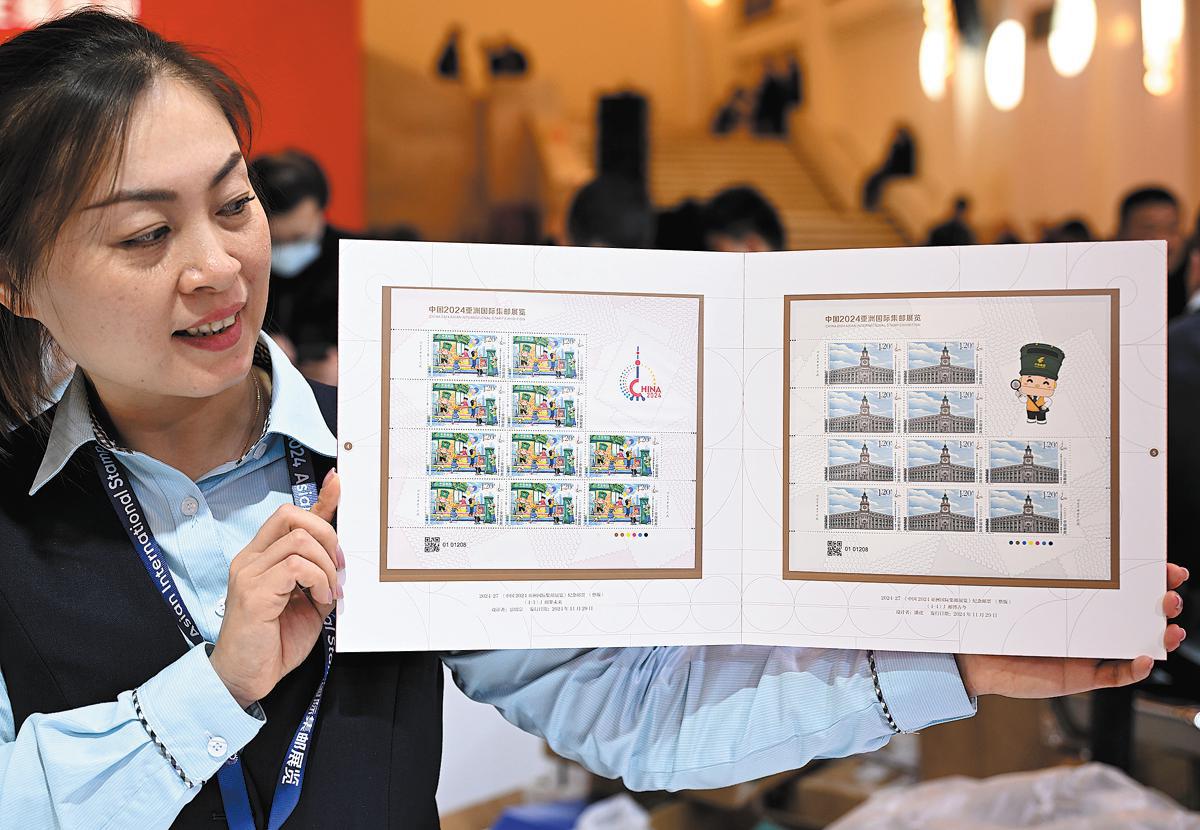
 0 Comment(s)
0 Comment(s) Print
Print E-mail China Daily, January 10, 2025
E-mail China Daily, January 10, 2025
With the rapid development of modern technology, communication has become almost instantaneous — just a tap of a screen. The once-cherished art of writing letters and affixing stamps seems like a forgotten relic. Yet, for a dedicated community of collectors, stamps are not just valuable artifacts but carriers of deep emotional connections, culture, history and art. Despite the prevalence of digital communication, this unique tradition remains alive, as evidenced by the passionate crowds that gathered at last year's China 2024 Asian International Stamp Exhibition in Shanghai.

A worker displays China Post stamps dedicated to the exhibition in Shanghai on Nov 29. LI HE/XINHUA
On Nov 29, the city witnessed an extraordinary gathering of stamp enthusiasts at the Shanghai Exhibition Center. The event buzzed with excitement as visitors of all ages flocked to the exhibition to celebrate the global art and culture of philately. Among them was 65-year-old Liang Bin, a seasoned philatelist from Taizhou, Zhejiang province. Liang had traveled to Shanghai for what he described as "a grand gathering for philately".
A collector for nearly 50 years, Liang was among the first to arrive, braving the chilly winter morning and standing in a long queue that stretched well beyond the entrance of the exhibition hall.
"It's not just about the stamps, it's about the connections," Liang said as he carefully affixed some stamps to a special envelope designed for the event. He was preparing to send these to fellow philatelists, some of whom he has been corresponding with for decades.
"I've been sending letters to a friend in Taiwan for over 30 years. We've shared our joys and sorrows, from family celebrations to losses, and even sent each other money in the post. We're more than friends, we're like family," he added.
For Liang, the act of writing and sending a letter is far from a simple task — it is a meaningful ritual. The exchange of letters, often adorned with carefully chosen stamps, had become a deeply rooted tradition for many philatelists.
Global celebration
The exhibition, which ran for five days, saw a remarkable turnout. According to the All-China Philatelic Federation, one of the event's coorganizers, the daily visitor numbers consistently reached capacity. Attendees came from across China and around the world, many of them passionate collectors who viewed the event as an opportunity to connect, learn and expand their collections. While the crowds were predominantly middle-aged and older, younger faces were also visible, underscoring the intergenerational appeal of philately.
"Stamp collecting is an important way for people from all over the world to exchange cultures and ideas," said Liu Wei, China's Transport Minister, at the opening ceremony of the exhibition.
"As a country with a rich philatelic culture, China continues to innovate and expand the influence of philately both domestically and internationally," Liu added.
Philately in China had experienced something of a renaissance, particularly after the 1980 release of the famous "Monkey Stamp", which remains highly valued by collectors today. However, experts suggest that the number of active stamp collectors in China has gradually declined in recent years, likely due to the increasing dominance of digital communication.
Prakob Chirakiti, president of the Federation of Inter-Asian Philately, acknowledged that while the volume of physical letters may have decreased, the emotional and cultural significance of handwritten letters and stamps has not diminished.
"It's different when you hold a handwritten letter from your mother, compared to just receiving a text," Chirakiti said.
"Stamps, in a way, serve as ambassadors — they tell stories."
For instance, China uses stamps to showcase its technological and architectural achievements, while Japan highlights its food culture and cartoons.
Chirakiti emphasized that philately remains an important medium of cultural exchange, especially in Asia, where the practice has flourished over the past several decades. Even in an age of digital communication, stamps continued to serve as powerful cultural symbols, connecting people across borders and offering a tangible link to history.
Benjamin Combes, philately development and documentary heritage program manager at the Universal Postal Union, agreed, noting that stamps are an effective vector for communication.
"They are a way to connect all levels of society — from industries to the environment — and they bring happiness and well-being to the people," he said. Combes also noted that philately transcends borders. "It's a universal language, a way of sharing stories and culture across all levels of society. It passes on the same messages, over and over again, bridging cultures and time."
Despite the challenges posed by digital communication, the future of philately appears secure, thanks to the efforts of collectors, designers and postal organizations. Combes noted that the stamp industry continues to evolve, adapting to new technologies like non-fungible tokens and digital stamps.
"We've seen the volume of physical letters drop in recent years, but the passion for philately remains strong," Combes said. "We are working to bring stamps into the digital age, making them accessible to a new generation of collectors through apps and other platforms."
Cultural narratives
The artistic and historical value of stamps are also major draws. Designers like Jiang Weijie, one of China's most renowned stamp designers, view stamps as "national calling cards".
"Stamps represent a country's culture, achievements and beauty," Jiang said. "They are much more than just a means of payment; they are windows into a country's identity."
Jiang's approach to designing stamps is meticulous, with an emphasis on artistic excellence.
"Once a stamp is issued, it can never be retracted. We must ensure that every design is flawless, as it represents not only the nation but also the cultural heritage of the people," he said.
His dedication to cultural representation is evident in the way Chinese stamps often features landmarks, historical figures and traditional customs — helping to tell the story of China's past and present.
Li Hao, a young stamp designer and engraver, feels fortunate to have found a profession he loves — engraving the steel plates used to make stamps. "There's a sense of fulfillment in turning a simple design into something tangible that will be part of history," Li said.
"It took me about 10 years to truly adapt to the profession," he added.
"After graduating from university, I joined the stamp factory, and when I was tasked with designing a stamp of the Mogao Caves (a UNESCO World Heritage Site in Dunhuang, Gansu province), I felt a deep connection with the Buddha sculptures. It was as if the art came alive as I engraved it, and I applied everything my teacher had taught me."
Yang Zhiying, a senior stamp designer and engraver, spoke of the delicate process involved in stamp engraving.
"A stamp is just 3 cm by 4 cm, but it takes two months for a skillful engraver to complete," Yang said.
"Every stroke must be perfect, and there's no room for error. If I make even a slight mistake, the entire plate is ruined, and we must start again with a new one."
Yang views stamp engraving as an essential cultural art that needs preservation. "We're training the next generation to keep this craft alive because it's not just about creating stamps — it's about preserving a meaningful cultural tradition," she said.
One of the most compelling aspects of philately is its ability to capture and preserve moments in time. Designers like Pan Hu, who has worked on several commemorative stamps, see stamp creation as a form of historical documentation.
"Stamps are like time capsules — they record moments in history. Every stamp is a piece of history," Pan said.
Connecting generations
Many stamp collectors, like Zheng Wei, a lifelong enthusiast with over 40 years of experience, see the hobby as a way to engage with history in a personal and meaningful way.
"When my brother gave me my first stamp album as a child, I didn't know how much it would shape my life," the 51-year-old recalled. "Now, I'm sharing this passion with my son, who's already started his own collection."
Zheng's experience reflects a broader trend in the philatelic community: many collectors pass their passion down to their children and grandchildren, ensuring the tradition of stamp collecting endures. "Philately brings joy and learning to every age," Zheng said.
"For me, it's not just about collecting; it's about connecting with the past, preserving memories and creating bonds with others."